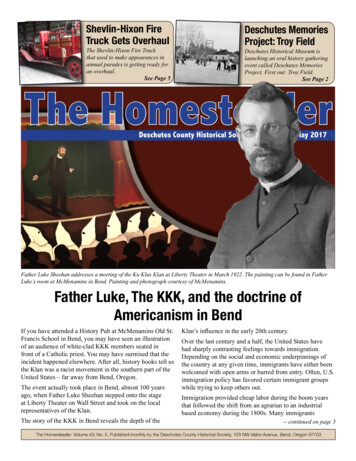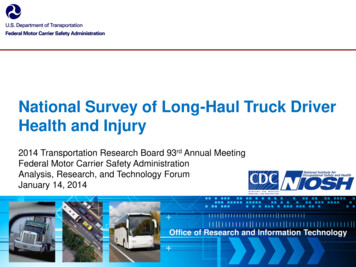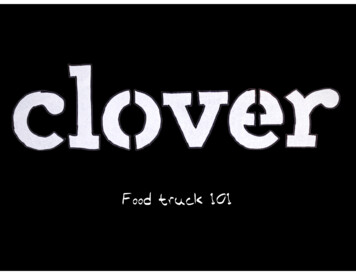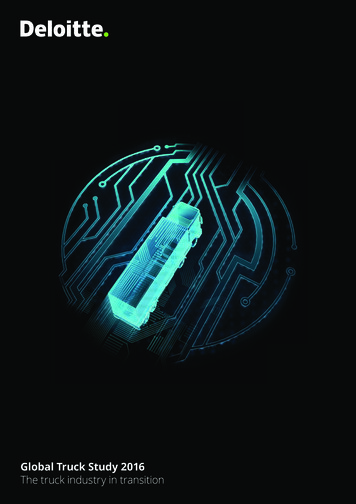
Transcription
Shevlin-Hixon FireTruck Gets OverhaulThe Shevlin-Hixon Fire Truckthat used to make appearances inannual parades is getting ready foran overhaul.See Page 5Deschutes MemoriesProject: Troy FieldDeschutes Historical Museum islaunching an oral history gatheringevent called Deschutes MemoriesProject. First out: Troy Field.See Page 2The HomesteaderDeschutes County Historical Society Newsletter – May 2017Father Luke Sheehan addresses a meeting of the Ku Klux Klan at Liberty Theater in March 1922. The painting can be found in FatherLuke’s room at McMenamins in Bend. Painting and photograph courtesy of McMenamins.Father Luke, The KKK, and the doctrine ofAmericanism in BendIf you have attended a History Pub at McMenamins Old St.Francis School in Bend, you may have seen an illustrationof an audience of white-clad KKK members seated infront of a Catholic priest. You may have surmised that theincident happened elsewhere. After all, history books tell usthe Klan was a racist movement in the southern part of theUnited States – far away from Bend, Oregon.The event actually took place in Bend, almost 100 yearsago, when Father Luke Sheehan stepped onto the stageat Liberty Theater on Wall Street and took on the localrepresentatives of the Klan.The story of the KKK in Bend reveals the depth of theKlan’s influence in the early 20th century.Over the last century and a half, the United States havehad sharply contrasting feelings towards immigration.Depending on the social and economic underpinnings ofthe country at any given time, immigrants have either beenwelcomed with open arms or barred from entry. Often, U.S.immigration policy has favored certain immigrant groupswhile trying to keep others out.Immigration provided cheap labor during the boom yearsthat followed the shift from an agrarian to an industrialbased economy during the 1800s. Many immigrants-- continued on page 3The Homesteader: Volume 43; No. 5. Published monthly by the Deschutes County Historical Society, 129 NW Idaho Avenue, Bend, Oregon 97703
Deschutes Memories Project: Troy FieldTroy Field – a year-around gathering place for Bend’s population. When it was cold enough, the fire department sprinkled the lot tocreate an in-town ice-rink. The top right picture shows an early Bend versus Prineville football game played at Troy Field.The Deschutes Historical Museum is launching a new oralhistory gathering event called Deschutes Memories Project.These events are a chance for people to gather and sharememories of a place or certain topic, including bringingphotographs and related artifacts.For the first Deschutes Memories Project, our membersand the public are invited to join us in sharing storiesand memories of Troy Field throughout the years onWednesday, May 10 from 4 to 6 pm. Bring photos andmemorabilia to share as the Deschutes County HistoricalSociety staff and volunteers will be on hand to digitize youritems for inclusion in the archives. Sip, snack, and socializewith fellow history buffs as we share stories of Troy Fieldand preserve your photographs for future generations.Deschutes Memories is joint project between theDeschutes Historical Museum and the Deschutes PioneersAssociation. Each Deschutes Memories Project event willfocus on a specific topic relevant to the Deschutes Countyarea. Meet at the museum at 129 NW Idaho Avenue inBend.Museum Staff:Board Members:Kelly Cannon-Miller, Executive DirectorVanessa Ivey, Museum ManagerShey Hyatt, RegistrarTor Hanson, Homesteader EditorTony DeBone, Adrian Bennett, Mike Berry,Andrea Hunnell DuPree, Beau Eastes,Greg Fulton, Karen Green, Tor Hanson,Loren Irving, Heidi Kennedy,Courtney Lupton-Turner, Bill Olsen,and Susie Penhollow 2017 DCHS Board of Directors:129 NW Idaho Avenue, Bend, OR 97703Open Tuesdays-Saturdays10:00 a.m. to 4:30 p.m.541.389.18132 THE HOMESTEADERNate Pedersen, PresidentMarsha Stout, Vice PresidentSue Fountain, Secretary/TreasurerComplete minutes of the meetings of the Board ofDirectors are on file with the Museum ry.org
Father Luke & KKK.– continued from page 1It is important to note this type of Americanism is farremoved from the “Americanism” promoted by the KuKlux Klan, who took the ideology many steps beyond itsoriginal meaning. Their ideology was built on the purity ofthe pioneer American stock and of Protestantism.Born as a secret Confederate club in Tennessee in 1866,the organization reacted to the threat to Southern whitesupremacy with the loss of the Civil War and the end ofslavery. The KKK bore down on recently freed AfricanAmerican slaves, using terrorism and intimidation to spreadfear among the black southern population.German emigrants boarding a steamer in Hamburg bound for theNew World. Harper’s Weekly, (New York) November 7, 1874settled in the urban centers and worked in emergingindustries such as steel, coal, textile, and later, auto.In the 1830s, most immigrants came from Germany,Britain, Scandinavia, Ireland and Central Europe. Aspolitical crisis and natural disasters marred the Europeancontinent, there was an increase in German, Irish, Britishand French immigrants. With that came a shift in religiousaffiliation, from Protestants to Catholics.By 1890, an increasing number of native born, well-offAmericans saw unregulated immigration as a threat to thehealth and well-being of the country. As many as 30 millionEuropeans immigrated to the U.S. between 1836-1914.This so-called “first KKK” disappeared from public eyes inthe mid-1870s. It was not until the publication of the book,The Klansman, in 1905 and the release of D. W. Griffith’smovie, The Birth of a Nation, in 1915, that the organizationsaw a resurgence in the United States.It should be mentioned the movie received top-billing at theGrand Theater in Bend in July 1915 (see illustration below).Maintaining their doctrines against African-Americans, thesecond iteration of the KKK perceived a new, second threatagainst white supremacy in the increasing flood of Jewishand Catholic immigrants from eastern and southern Europe.Bolstered by the national movement for Americanism andnaturalization of new Americans, and under the battle cryof “One Hundred Percent Americanism,” the Klan spreadbeyond its southern roots. The organization now ran as abusiness with national and state representation. Paid, fulltime recruiters scoured cities for potential members. The-- continued on page 4The anti-immigrant sentiment continued to permeatesociety and gained strength as the European nations went towar in 1914 and thousands of refugees arrived at the shoresof the United States. By the time the United States enteredWorld War I in 1917, one third of the country’s populationwas born abroad or had parents who had immigrated to theU.S.As the war deepened and more U.S. soldiers were sentto France to shore up the Alliance, the Americanismmovement started flourishing on the home front. Driven inpart by the involvement in World War I, the main streamsupport for the cause, and deep-seated patriotism, theideology of Americanism spread throughout society.The American Legion, which was founded shortly afterthe Allied victory in Europe in 1918, defined Americanismas the devotion and allegiance to the United States, itsflag, traditions, customs, and/or culture. It became an ideathat permeated society after the victory in Europe. As thesoldiers came back from the war, they were no longer IrishAmericans, Jewish-Americans, Catholic-Americans, or anyhyphenated-American groups of people – they were simplyAmericans. There was a belief that the rest of society wouldfollow suit.THE HOMESTEADER3
The two Bend mills – Shevlin Hixon to the left and Brooks-Scanlon to the right, employed a large group of immigrant workers. During theearly 1920s, the mills adopted the doctrine of Americanization in order to have their employees become American citizens.Father Luke & KKK.– continued from page 3Klan recruited heavily from other fraternal organizationssuch as the Masons, as well as Protestant clergy fromMethodist, Presbyterian, and Christian churches. In themid-1920s, the organization claimed to have a membershiproster of 4-5 million.Oregon was not immune to the activities of the KKK.In 1920, the state had 800,000 citizens and was to ahigh degree all white and professed Protestants. Theorganization got foothold in large cities like Portland,Salem and Eugene, as well as in many smaller cities inrural southern, eastern and central Oregon. This includedBend, which at the height of their influence boasted amembership of at least 350 members.Like the rest of America, Bend’s lumber mills and localschools participated in the nationwide effort to naturalizeimmigrants and celebrate the new American Melting Potunder the wave of Americanization. In January 1920, theBulletin ran a short blurb about the effort to “Americanize”Brooks-Scanlon’s workforce.“A systematic campaign of Americanization has been goingon for several months in the sawmill and lumber yards ofBrooks-Scanlon Lumber Co.,” according to M. G. Wagner.“The results now are beginning to manifest themselves withonly nine employes (sic) out of more than 370 who are notnaturalized or on the way to naturalization.”The description of an upcoming junior high schoolproduction in March 1921 provides insight into the formsof Americanization used in Bend’s schools:“Pupils of the junior high school are being coached by Mrs.Maude M. Grant for the presentation of The Melting Pot,on the Americanization of the stranger within our gates.”4 THE HOMESTEADERThe play included a cast of boys and girls playing theirparts as Hungarian, Slav, Greek, Italian, Swiss, Polish,Swedish, Irish, and Jewish immigrants. The cast wasrounded out with Uncle Sam, a Boy Scout, Teacher, and aDaughter of the American Revolution.However, that same issue of the paper – March 16, 1921,also ran a front-page article about Charles B. Rucker,chairman of the American Legion unemploymentcommittee in Portland, stating that, “Bend is the third cityin the state in the employment of alien labor.”Mr. Rucker announced that he was on his way to Bendwithin the next two weeks, “[to] call on employersand request the dismissal of alien laborers in order thatAmericans who needs jobs may be substituted.”At the weekly luncheon of the Commercial Club, acommittee headed by Clyde McKay with Carl A. Johnsonrepresenting Shevlin-Hixon and H.E. Allen representingBrooks-Scanlon, reported they were investigating Rucker’ssources. Frank R. Prince of the Percy A. Stevens post No.4, American Legion, seriously questioned Rucker’s figuresshowing that “Bend is an important offender in the matterof employing aliens.”This attack from outside gave rise to conflict betweenlocal KKK members and the community at large. Oneof the KKK’s political goals was the enforcement ofAmericanization and it was long rumored that Bend’s twosawmills, Shevlin-Hixon and Brooks-Scanlon, had KKKmembers among its workforce who nudged immigrant coworkers to adopt the American Way. It is safe to say thateven with the Klan’s presence in Bend, the city’s citizenswere not buying in to the message. On the contrary. TheBulletin reprinted an article from Klamath Falls’ leadingnewspaper on the editorial page with the followingintroduction:-- continued on page 6
Local News ItemsShevlin-Hixon Fire Truck Gets a RestorationThe Shevlin-HixonFire Truck that used tomake appearances inannual parades is gettingready for an overhaul.Last fall, the museumwas pleased to hostthe Hixon family foran afternoon of sharedhistory as the familytraveled to Bend to learnmore about their rolein the logging industryin Central Oregon. Insupport of the museum, the Hixon Family Foundationsent a donation of 15,000 to help overhaul the fire truck,which has been stored with Bend Parks and Recreationfor the past several years. The truck no longer ran andtime had not been kind to the paint job. We received thenews of the foundation’s support in November and beganplans to move the truck to start repairs.the barn roof collapsed.Fortunately, the damagecould have been so muchworse--while the cab ofthe truck was dented,none of the windowswere broken and nobeams fell across the fireequipment pieces.Thanks to ConsolidatedTowing, who donatedtheir services to thecause, the truck has beenmoved to Wade Bryant’sto begin work on getting the truck back in tip top shapeand ready for the road. Stay tuned to The Homesteaderfor updates as we hope to unveil the truck at the SummerCookout on August 13.Then the snow started to fall, delaying the move. Sadly,Bend Parks and Rec staff later had to call to tell us thatWhat Is It?An Artifact Identification EventHave a cool antique or collectible that you’re just notsure what the heck it is? Bring it to the DeschutesHistorical Museum on May 24 from 4 to 8 pm.Bring your strange, unknown antiques or collectiblesto the Deschutes Historical Museum for our What is it?identification event.Antique experts from the community and DeschutesHistorical Museum staff will be on hand to help identifythose unknown objects lurking in your family heirlooms.Ward Tonsfeldt from Reels and Creels, Wendy Sextonof Trivia Antiques, homestead legend Bob Boyd, andlocal builders will offer their expertise. Smaller items arepreferred.Please, no art work, firearms, or large furniture —appraisals will not be provided.Reservation System Now Requiredfor History PubFollowing many requests from History Pub patrons,we are now requiring reservations. Reservations can bemade on the museum’s website, www.deschuteshistory.org by clicking on the History Pub event on the eventcalendar. Reservations do not guarantee a table orspecific seat, which will still be first come, first serve. Byimplementing the reservation system, patrons who areunable to line up early are still able to attend.Reservations will begin on the first of each month forthat month’s History Pub. If you have trouble registering,please call the museum at 541.389.1813 for assistancegetting on the list. Thank you to everyone who continuesto make History Pub so popular.THE HOMESTEADER5
Father Luke & KKK.– continued from page 4“Threats of business losses, statements of membershipthat are not true and assertions of official position that arefalse are some of the aspects of Klamericanism seen in thepresent activity of the K.K.K. organizers in Bend. Hereseems to be one of the times when the best advice is notto hitch your wagon to a star. Just keep your feet on theground and use the white nightie as a sleeping argument,not a means of concealing identity.”The conflict between moral decency and radical racismcame to a head inBend in the yearsbetween 1922 – 1924.The opposing partiesincluded The Bulletinand the CatholicChurch on one sideand the KKK on theother side.The Klan inOregon was ledby Grand DragonFred L. Gifford, aMinnesota nativeand active Mason.Headquartered inPortland, the KKKwas active all over Governor Walter M. Pierce came to powerthe state. Giffordthanks to the support from the KKK.and his croniesworked hard behind the scenes to influence prominentpolitical figures to drive the KKK’s agenda in Salem.With support from Democratic gubernatorial candidateWalter M. Pierce and an installed base of KKK-friendlylegislators, the Klan drove the passage of the CompulsoryEducation Act of 1922, an anti-Catholic and anti-Semiticeffort to close Catholic schools in Oregon.The Klan thanked Pierce for his support and helped electhim Governor in 1923. It is worth mentioning that theschool education act was later struck down in the UnitedStates Supreme Court in 1925 as unconstitutional.The Ku Klux Klan agitated against the Catholic churchwith the help of former Portland Christian Churchpastor Rueben H. Sawyer, lead spokesperson for theKlan in Oregon. He travelled around the state and madepresentations about the organization and its mission. In1922, it was reported that over 100 men in La Grande paidfifty cents each to hear Sawyer speak.On March 15, 1922, Sawyer arrived for a show in Bend atthe Liberty Theater. At some point before the show, Sawyeroffered that anyone could challenge any statement he made6 THE HOMESTEADERduring the presentation.As the program got underway, Father Luke Sheehanapproached the stage to challenge two charges Sawyermade about the Catholic Church. The local newspaperreported the interaction.“The unusual spectacle of a Catholic priest, standing ona platform banked with knights of the Ku Klux Klan,challenging charges made by their spokesman, R. H.Sawyer, was witnessed by the audience at last night’s showat the Liberty Theater.”“Two of the klansmen sitting at the back of the stageadvanced in a manner threatening forcibly to eject thepriest, but the speaker restrained them. He allowed FatherSheehan to speak for a few minutes, then insisted that heretire.”Sheehan challenged Sawyer’s assertion “the Catholicchurch attempts to suppress the Bible, and that the Popeis the political leader of Catholics in America.” Sheehandenied both charges, declaring that “the Pope has nodominance over his followers except in a spiritual way.”The short front-page article headlined, Klan ProgramInterrupted, ended:“Sawyer made no further reference to the suppression ofthe Bible, but did read several statements which he saidwere made by Catholic officials and printed in Catholicmagazines.”The local newspaper took a continued stand against theKKK, publishing several editorials from newspapersaround Oregon on the topic of the Klan. A month afterFather Luke interrupted the KKK meeting, The Bulletinpublished an editorial from the Salem Capital Journaltaking a strong stand against the Ku Klux Klan:“Most senseless of all the group antagonism existing infree America is the religious – and yet in Portland therewas a class of 1200 initiated into the Ku Klux Klan,whose purpose is thespread of racial andreligious prejudicesand antagonism.This is in itself asorry commentaryon conditions in themetropolis.”In 1968, attorneyWillard K. Careyuncovered theminutes of the KKKin La Grande. Laterpublished in DavidA. Horowitz’s book,-- continued on page 7Father Luke Sheehan and a group ofstudents from the Catholic school
Father Luke & KKK.– continued from page 6Inside the Klavern, theminutes of KKK meetingsin La Grande covered theperiod from May 18, 1922through April 22, 1924,approximately the sameperiod the Klan was activein Bend.The La Grande minutesoffer an interesting viewof the Oregon KKKleader Gifford and histhoughts on the Catholicrepresentatives in Bend.In a notation from theminutes of the January26, 1923 special meeting,when Gifford met withthe La Grande chapter ofthe Klan, the following isreported.“Mr. Gifford informed us that the Pope has one of hisrepresentatives at Bend, Oregon. ‘I don’t recall the goodFather’s name. Anyway, we may expect some trouble fromthis bird as we know him to be a big man politically andthat he isn’t in Bend for no special good.’”The Catholic representative Gifford is referring to maybe either Father Dominic O’Connor who had come fromIreland to Bend in December 1922 or Father Luke Sheehan.Perhaps based on the early 1923 La Grande meeting,the Bend KKK decided to make a statement against theCatholic church and the local newspaper. The first incidenttook place in July 1923, when residents around Pilot Buttesaw a blazing cross on the summit. The Bulletin reported:According to The Bulletin, a total of eight cars took part inthe parade that passed “south of Wall street, down Franklinto Congress, and east of Delaware, then returned to thecenter of the city and wound slowly around the businessstreets.”On the second pass through downtown Bend, it was clearthat the KKK procession were taking a stand against TheBulletin.“On its second trip past The Bulletin office, a klansman inthe front machine leaned out and ordered ‘blow your hornat The Bulletin office.’”The procession of cars continued to the Klan’s headquarterson Hill Street and then eastwards towards Pilot Butte. Asthey approached the butte, a car had been placed at the roadleading up the summit.“[ ] Several men, some in robes, some in plain clothes,halted each car and conferred with each occupant. One ofthose standing there was Justice of the Peace E. D. Gilsonwearing a klansman’s robe.”The Klan gathering at the summit of Pilot Butte ended withanother fiery cross that started burning shortly before 9o’clock, and was still alight at 10:30. “The effect is securedby burning box factory waste soaked with oil.”The Bulletin article also contained a run-down of theregistered owners of the cars in the procession. Thecars belonged to A. R. Barnett of The Dalles, CliffordA. Bushong, H. A. Henderson, H. C. Friedley, James T.Sheppard, and D. D. Ogle all of Bend. Two cars listed hadrecently been sold, and The Bulletin printed an apology thefollowing day to the two owners, who categorically deniedbeing a part of the KKK.The five Bend men listed in The Bulletin article wereall employed at the Brooks-Scanlon Lumber Company,which makes for a significant piece of evidence that atleast one of the two mills had Klan members among its-- continued on page 8“It shone for several minutes, then collapsed into a singleblaze and died out. The demonstration is generally creditedto the Ku Klux Klan.”“One automobile load of white clad figures was seenheaded towards the butte before 10 o’clock, by the localpolice, who were in the northeast part of town investigatinga report that someone had been shooting a revolver or riflein that vicinity.”The second incident took place in September 1923, whenthe Klan paraded through the main streets of Bend on theirway to a Klan ceremony on Pilot Butte.“The parade, first seen about 8 o’clock was led by anautomobile [ ] decorated with an electrically lightedcross, mounted on front of the hood. The second car [ ]carried an American flag on the left side.”The Bulletin office on 812 Wall Street became the ire of the KKKduring a procession through Bend in September 1923.THE HOMESTEADER7
Father Luke & KKK.– continued from page 1employees. Although no names were linked to ShevlinHixon personnel, it is not without reason to speculate thatmembers worked at that company as well.The Bulletin took an immediate stand against the Klanand what had transpired the previous day. In an editorialpublished on September 8, 1923, headlined On CertainAmerican Principles, the writer noted the following:“In common with a good many other American citizenswho, like us, have no connection nor affiliation with theCatholic church we deplore such an attack on that churchas was made by a Ku Klux Klan speaker Thursday night.We deplore that sort of thing just as we would deplore anattack on any other decent and law abiding organization orinstitution. [ ] It is most unfortunate that at a time whenthere are so many real problems in our national life to bedealt with that misguided zealots should go stirring up theold embers of religious hatred and fanaticism.”The Klan’s location in Bend was not a secret. E. D. Gilson,the former Mayor of Bend (1921-1922), is listed as thelocal Ku Klux Klan representative (Exalted Cyclops, or thechief officer of a Klan) in the 1924-1925 Polk Directorywith an office in the O’Kane Building on Oregon Avenue.He is also listed under “Real Estate and Investments” onthe same address.The Klan in Bend came to a fiery end only a year and ahalf later. In April 1925, the Bulletin reported that OregonGrand Dragon Fred Gifford was accused of interferingin Bend Klan business, something local members werestrongly against. From 1924 to 1925, the local organizationlost “at least half a hundred [ ] members” due to heavyhanded interference. In addition, another 300 members lettheir membership lapse.The dwindling Klan membership in Bend split ranks. Afaction under the leadership of I. G. Shaw, former pastor ofthe Christian church in Bend, tried to unseat G. H. Baker,who had taken over the Bend Klan afterE. D. Gilson the year prior. A coup wasset to take place on March 13, but wascancelled after the secret meeting insteadwas held in open forum at the LaborTemple. Confronted by H. W. Giddings,a former Portland man who was putin charge of Klan affairs in Crook andDeschutes counties, Baker and his cohortsCurtis Beesley, Floyd Turner, and Dr.Frances Bloom were sent into retreat.The two issues finally came to a headon April 11, when Giddings declaredthat the charter of Bend Klan No. 398 THE HOMESTEADERhad been revoked and a new charter had been opened andnew officers appointed, though no names were mentionedin the article. Giddings also stated, “the klan, locally andnationally, is entirely out of politics, and exists solely upona basis of Americanism as laid down in the klan doctrines.”With that, the KKK in Bend went dark. There were noother Klan activities reported in The Bulletin except for aneditorial in June 1925 titled, Where the Oregonian Stands,that briefly mentions the Masons and the Klan.Gifford’s dictatorial rein came to an end in 1925. TheKKK lost its influence in Oregon and elsewhere during theDepression and war years. The Klan reared its ugly head ageneration later during the Civil Rights Era, again agitatinghatred against the African-American population in theSouth.The United States under President Hoover continueda dualistic approach to immigration – a kind of goodversus evil approach depending on the times. In a speechin Elizabethton, Tennessee in early October 1928, thepresident made his policy perfectly clear, “I do not favorany increase in immigration.” As the economic downturnof the Great Depression gripped the United States,immigration fell to a trickle.Father Luke passed away in February 1937 at the age of63, after serving 27 years as a pastor in Bend. The editorialwriter in The Bulletin noted, “Father Sheehan was achurchman who held steadfastly to lofty ideas. Those idealsincluded full recognition of citizenship. He accepted themand discharged them as he accepted and discharged allhis duties.” Described as a kind and helpful man, “FatherSheehan was loved and respected throughout his sphereof influence. His going is mourned by all who knew himwhether of his church or not.”Bend came to a still on February 17, 1937 when FatherLuke was laid to rest. He was buried in the Pilot Buttecemetery beside his nephew, Rev. Dominic O’Connor whodied in November 1935.– Tor Hanson
Events MAY 10MAY 13MAY 24JUNE 1-5Geneology MAY 10MAY 17MAY 19MAYLectures MAY 10MAY 18MAY 22MAY 304-6pm Deschutes Memories Project: Troy Field, Deschutes Historical Museum10-2pm Redmond Hunt for History & Photo Contest Winners, Centennial Park4-8pm What Is It? Antique & Collectible Identification, Deschutes Hist. Museum2017 Rock Art Symposium, Eagle Crest Resort10am Santiam Wagon Road Walk at Whychus Canyon12pm Know Roots: Beginning Genealogy, La Pine Public Library Guided Tours9:30 Indian Ford Meadow History Outing/WanderFriday/Saturdays,10am Guided Tour of Historic Downtown Bend, Bend Visitor Center12pm Training for WWII on the High Desert, High Desert Museum6pm Mount St. Helens: Survival & Revival of Life After a Major Volcanic Eruption, SunriverNature Center6pm A Complicated Legacy: The History of the Hanford Site, High Desert Museum5:30pm History Pub:Oregon’s Heritage Trees, McMenamin’s Old St. Francis SchoolHistoric Preservation Meetings MAY 16MAY 266pm Bend Historic Landmarks Commission, City Hall4:30pm Redmond Historic Landmarks Commission, City HallCongratulations to Bend and Redmond for their 2017 city/building recognition for heritage and historicpreservation, more info on website below.THE HOMESTEADER9
Heritage Walking Tours of Downtown BendThe Deschutes Historical Museum invites you to spend a morning with us this summer. All tours leave from theDeschutes Historical Museum at 10:30 am. Reserve your spot as space is limited, please call 541-389-1813“The Early Days of Bend”Travel back to when the river waswild, the Ponderosa Pines wereplentiful and Bend the Beautiful wasa town in the making. the storiesof 6 “Bend-ites” and how theseresidents helped transform a younghamlet into a booming town. TourStarts at the Deschutes Historical Museum (Reid School)and ends at Lone Crow Bungalow on Wall Street.When: June 3, June 17, July 1, July 22, August 12,August26Time: Approximately 1 hour Length: less than a miletraveling through old neighborhoods and parkways.“Reflections of History: Architectural Stylesof A Neighborhood”Stroll through Drake Park Neighborhood Historic Districtand take a step back in time when walking was the thingto do and neighborhoods were all about proximity. Thetour will introduce the architectural styles representedin the neighborhood while sharing history of a changingcommunity.Tour begins and ends at theDeschutes Historical MuseumWhen: June 10, June 24, July 8,August 5, August 19Time: approximately 1.5 hoursPrice: 5, Members are freePrice: 5.00, Members are freeWe recommend the following: wear comfortable walking shoes, dress for the weather, bring water,and don’t forgetyour camera! It does get hot so a hat is good too. Length: One mile, traveling through old neighborhoods pavementcan be uneven at times. Not recommended for wheelchairs. No tours July 15 or July 29Mark Your CalendarsMAY13A MURDER MYSTERY AT THE MUSEUM:Support the MVHS theatre department as theytell their accounts of the fictional murder ofschool teacher, Miss Rose Foster.Deschutes Historical Museum30-minute tour. Admission is 5 per person.Come anytime between 2-3:30 and 5-6:30.24WHAT IS IT? AN ARTIFACTIDENTIFICATION EVENT: Bring yourstrange, unknown antiques or collectibles to themuseum. Staff will help identify those unknownobjects lurking in your family heirlooms.Deschutes Historical Museum4 p.m. - 8 p.m.30HISTORY PUB: THE ROOTS OF HISTORY:OREGON’S HERITAGE TREES. Presentedby Nate Pedersen, Community Librarian withDeschutes Public Library and Board President ofthe Deschutes County Historical Society.McMenamins Old St. FrancisFather Luke Ro
Deschutes Historical Museum and the Deschutes Pioneers Association. Each Deschutes Memories Project event will focus on a specific topic relevant to the Deschutes County area. Meet at the museum at 129 NW Idaho Avenue in Bend. Troy Field - a year-around gathering place for Bend's population.










